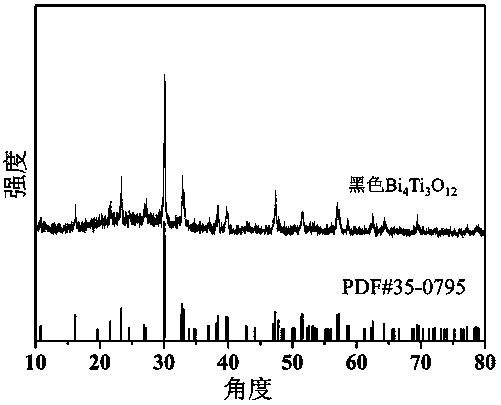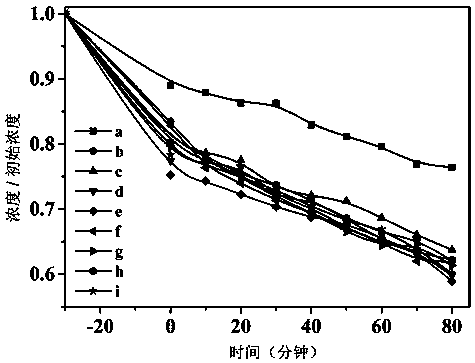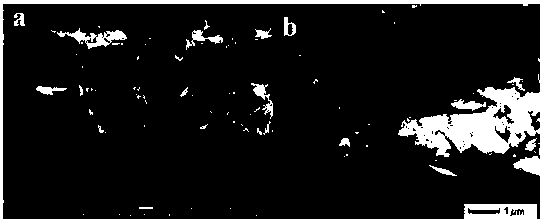Preparation method of black Bi4Ti3O12 material and application thereof
A black, certain amount of technology, applied in chemical instruments and methods, water/sludge/sewage treatment, metal/metal oxide/metal hydroxide catalysts, etc., can solve the problems of narrow response range and consumption of photocatalytic materials
- Summary
- Abstract
- Description
- Claims
- Application Information
AI Technical Summary
Problems solved by technology
Method used
Image
Examples
Embodiment 1
[0024] (1) Bi 4 Ti 3 o 12 Preparation of materials:
[0025] Grind 0.47 g of bismuth oxide, 1.7 g of sodium chloride and 2.2 g of potassium chloride evenly, then add 0.12 g of P25 and grind them evenly; Calcined at ℃ for 2 h, cooled naturally, washed with deionized water, and dried to obtain Bi 4 Ti 3 o 12 Material.
[0026] (2) Black Bi 4 Ti 3 o 12 Preparation of materials:
[0027] 0.5 g Bi 4 Ti 3 o 12 Materials with 0.1 g NaBH 4 Grind fully and evenly, and put the mixture in a tube furnace at 300°C for calcination for 30 min under the condition of feeding argon protective gas, cool to room temperature naturally, wash with deionized water until neutral, and dry to obtain black Bi 4 Ti 3 o 12 Material.
[0028] (3) Photocatalytic degradation test:
[0029] Take the black Bi in step (2) 4 Ti 3 o 12 The photocatalytic degradation test was carried out on the material samples in a photochemical reaction apparatus, and the degradation rate of tetracycline by t...
Embodiment 2
[0031] (1) Bi 4 Ti 3 o 12 Preparation of materials:
[0032] Grind 0.47 g of bismuth oxide, 1.7 g of sodium chloride and 2.2 g of potassium chloride evenly, then add 0.12 g of P25 to grind evenly; put the above mixture into a muffle furnace for high-temperature calcination, calcination at 750°C for 2 h, and cool naturally , washed with deionized water, and dried to obtain Bi 4 Ti 3 o 12 Material.
[0033] (2) Black Bi 4 Ti 3 o 12 Preparation of materials:
[0034] 0.6 g Bi 4 Ti 3 o 12 Materials with 0.1 g NaBH 4 Grind fully and evenly, and put the mixture in a tube furnace at 300°C for calcination for 30 min under the condition of feeding argon protective gas, cool to room temperature naturally, wash with deionized water until neutral, and dry to obtain black Bi 4 Ti 3 o 12 Material.
[0035] (3) Photocatalytic degradation test:
[0036] Take the black Bi in step (2) 4 Ti 3 o 12 The photocatalytic degradation test of the material samples was carried out in...
Embodiment 3
[0038] (1) Bi 4 Ti 3 o 12 Preparation of materials:
[0039] Grind 0.47 g of bismuth oxide, 1.7 g of sodium chloride, and 2.2 g of potassium chloride evenly, then add 0.12 g of P25 to grind evenly; put the above mixture into a muffle furnace for high-temperature calcination at 750°C for 2 h, and cool naturally. Washed with deionized water and dried to obtain Bi 4 Ti 3 o 12 Material.
[0040] (2) Black Bi 4 Ti 3 o 12 Preparation of materials:
[0041] 0.7 g Bi 4 Ti 3 o 12 Materials with 0.1 g NaBH 4 Grind fully and evenly, and put the mixture in a tube furnace at 300°C for calcination for 30 min under the condition of feeding argon protective gas, cool to room temperature naturally, wash with deionized water until neutral, and dry to obtain black Bi 4 Ti 3 o 12 Material.
[0042] (3) Photocatalytic degradation test:
[0043] Take the black Bi in step (2) 4 Ti 3 o 12 The photocatalytic degradation test of the material samples was carried out in a photochemic...
PUM
 Login to View More
Login to View More Abstract
Description
Claims
Application Information
 Login to View More
Login to View More - R&D
- Intellectual Property
- Life Sciences
- Materials
- Tech Scout
- Unparalleled Data Quality
- Higher Quality Content
- 60% Fewer Hallucinations
Browse by: Latest US Patents, China's latest patents, Technical Efficacy Thesaurus, Application Domain, Technology Topic, Popular Technical Reports.
© 2025 PatSnap. All rights reserved.Legal|Privacy policy|Modern Slavery Act Transparency Statement|Sitemap|About US| Contact US: help@patsnap.com



